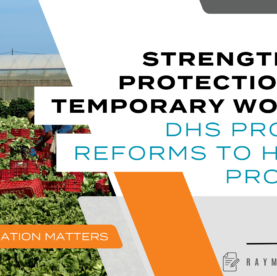Labor Shortage: Will Additional Seasonal Visas Help?
The United States is in the midst of a significant labor shortage. In response to the growing demand for labor, the U.S. government recently announced it will expand the number of H-2B visas available for seasonal workers this winter. Although the announcement is hailed by some as necessary, critics suggest the response may be insufficient to meet growing demand.
The Modern Labor Shortage
Following the economic turmoil spawned by the COVID-19 pandemic, the U.S. economy faces an unusual set of circumstances: instead of a lack of jobs, there is a lack of workers to fill available positions. Experts attribute the labor shortage to a number of potential causes, but some suggest a lack of immigrant labor is at least partially to blame. Due to lengthy processing times for immigration applications, foreign born workers hoping to enter the United States face unprecedented challenges obtaining the necessary paperwork to work here legally.
Biden Administration Expands Seasonal Visas
In response to the growing challenges of the labor shortage, the Department of Homeland Security (“DHS”) and the Department of Labor (“DOL”) recently announced they will issue a joint temporary final rule to make available an additional 20,000 H-2B temporary nonagricultural worker visas. These visas will be set aside for U.S. employers seeking to employ additional workers on or before March 31, 2022.
The visas are in addition to 33,000 visas already set aside for seasonal employers, marking a substantial 60% increase from the previous limit.
What is the H-2B Program?
The H-2B visa program allows U.S. employers who meet specific regulatory requirements to bring foreign nationals to the United States to fill temporary nonagricultural jobs. The industries most reliant on the H-2B program vary, but include landscapers, hotels, and ski resorts. By providing foreign workers to meet labor shortages in the United States, the program is meant to support the fluctuating needs of the U.S. economy.
The program has restrictions, however. The employment must be for a limited period, including seasonal or intermittent needs. To hire H-2B workers, employers must, among other things, certify to a lack of U.S. workers available to fill the position. Additionally, employers must certify that using the program will not adversely affect wages for similarly-employed U.S. workers.
Will Additional Seasonal Visas Be Enough?
Expansion of the H-2B program is being praised as necessary relief by some. However, others suggest it may not be sufficient to answer the growing labor demand in the country.
Business owners from Cape Cod, Massachusetts, hailed the news, citing the strained vacation industry that relies so heavily on seasonal workers to meet the high demand. Additional workers will provide necessary relief on many strained industries.
Steve Yale-Loehr, a professor of immigration law practice at Cornell, recently noted that if employers get past these hurdles, the visas could help the labor shortage, but only a little bit. After all, the labor shortage in the United States exceeds the additional 20,000 seasonal visas being offered. Recent estimates suggest 10.4 million jobs are available here. Moreover, applications under the H-2B program can be costly, forcing employers to weigh the financial implications of sponsoring workers under the program.
Certainly, the availability of additional H-2B visas will provide essential relief to some businesses, but the extent to which it relieves the labor shortage as a whole remains to be seen. To learn more about this blog post, or if you have any other immigration concerns, please feel free to contact me at rglahoud@norris-law.com or (484) 544-0022.




